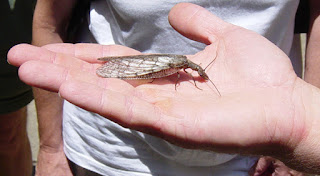I realize that this could be stepping on a land mine. None the less what I think is very true.
Today we have evolved our fly fishing game to the point of why do we use fly style rods and reels for what is obviously not fly fishing in the origins sense of weightless presentation?
Ask anyone over the age of fifty about "Chuck And Duck. Go ahead. You will be told it is the art of using a weight connected to leader to bounce the bottom so that a lessor weight fly can lead the way to the fishes mouth. It was called "Chuck And Duck" because the weights being thrown became so heavy over time that bouncing it on the bottom meant lifting out of every rock hold. It was deadly and especially the favorite way to fish on Great Lakes steelhead tributaries.
For a time, it was even legal in the fly only sections. Today, the slinkies made from nylon para cord and filled with weights have given way to a weighted fly.
If you think I am sounding negative about Euro style angling I am sorry for the misconception. I know how effective the style can be and if used in legal ways is no different than any other legal method to catch fish.
Let's go back to my original thought. Why are we using a fly rod and fly reel to do this form of angling? I understand that in competition it is a requirement for certain equipment but not on your local stream. If using the most effective way is the goal then why? To fish legally in fly only water we must use fly gear and fly line without regulation on leader length. You might understand how those cutting back the fly line and having a 30 foot leader might seem a bit dubious.
But if you really want the most effective form of bouncing flies in a perfect drift with river flow then the Micro Trout Float or Spin set up will be your choice in all but those fly fishing only waters. Micro float is much more effective in getting into locations and not be walking through sensitive eco systems. I have watched anglers walk through spawning beds to get over to the next spawning bed.
How about we take one style of rod. An eleven foot carbon three weight with a specially designed two weight tip for sensitivity. Perfect Euro, Perfect Float, Perfect Spin. Now depending upon the style and location of the reel seat will really be the only factor in rod design.
Casting - There is no doubt that from a casting standpoint the spinning reel is going to offer the easiest cast from short to distance. No overhead style is needed. Just a pendulum underhand flip. Then the use of an indicator and belly weighted fly line. Then using a spinning reel with float. Then a centrepin and finally a fly reel with mono rig.
Presentation - Fish want our flies moving exactly as an object would move if no line were attached with no added weight. I think that being able to control speed and direction is of greatest importance and here is where the Euro method shines. Limited drag on line and placement directly where the fish will be is key. We are far more connected to having the leader and flies moving exactly how the fish wants. At the same time using the float with pin or spin offers the ability to set a perfect depth and have exacting laminar drift exactly with the current. Float weights and weight set up does this perfectly. The long drift means more fishing time and less casting time. Using the indicator method does a bit of both but no where near as effective as the float or pin.

Ecology - We all can agree that any form of angling has ecological consequences. Line, weights and hooks are all lost by us all. The only factor that bothers me about working with such short connection is walking through streams to access as many possible locations as possible. I also know that we as anglers understand this and all try to stay off the redds, move as few rocks as possible and climb in and out with the least effect on bank erosion.
Fish Hooking - The great advantage to Euro Nymphing is the direct contact to the take. I have done experiments watching landlocked salmon take a fly in their mouths and instantly spit it out. I never felt a thing. With Euro you are in direct contact with that feel and the best chance of knowing to set a hook. All other forms of float and indicator rely on sight and that is never immediate.
Condition - To me, the conditions make for obvious choices. Target fish, deep water, big rivers, high and fast, low and slow flows and hot or cold temperatures all make our style choices.
In conclusion, I am of the firm belief that we all choose the style of angle we like and that your personal preference is the right choice. If mine is the swing and and yours the dry fly who am I to change your mind.
William


































.JPG)







